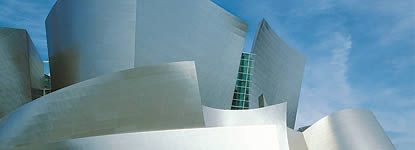
Acclaimed conductor, organist and harpsichordist Harry Bicket and the English Concert joined chords with gifted American countertenor David Daniels on Tuesday, March 24, at Walt Disney Concert Hall. This evening of masterworks by Johann Sebastian Bach and George Frideric Handel marked the latest installment in the L.A. Philharmonic Baroque Variations series.
Daniels recently teamed up with the English Concert, the world-renowned chamber orchestra of which Bicket was named artistic director in 2007, for their critically acclaimed recording of Bach cantatas and arias on Virgin Classics. Four of these works were on the program at Disney Hall, and they were every bit as precise and eloquent as the studio-produced versions – perhaps even better given the extraordinary gestural interpretation that Daniels and Bicket brought to the stage.
Though Bicket, the English Concert, and Daniels have performed these works together on many occasions, Tuesday’s concert had freshness, an unmistakable enthusiasm and a comfortable lightness of spirit.
Bach’s First Orchestral Suite (BWV 1066), which opened the program, had all of the instrumental athleticism one would expect. From his keyboard, Bicket charmed intricate melodic lines from the orchestra with large fluid motions, while enhancing each phrase with facial expressions and popping hands. The ensemble stroked the textures and hues of the suite marvelously, and the reeds gave a stellar performance.
Enter David Daniels. His superb voice quality was evident from the first syllable of “Vergnügte ruh” (BWV 170). The stratospheric pitches and even tonal quality across his range attested to his technical prowess. He is indeed a countertenor of the highest order, and in combination with the ever-changing inflection and prosodic nuance he convincingly applied, he proved to be in a class of his own. Katherina Spreckelsen’s mellow oboe d’amore blended perfectly with unison violin as they fused into a single, rich instrument trading phrases and artistically mixing with Daniels’ unique voice.
Spreckelsen was again in the foreground with her alluring warm tone, as she ably captured the plaintive, conciliatory affect of the “Qui sedes” from the B minor Mass. The interplay between the solo oboe d’amore and Daniels was memorable, but although she physically separated from the reeds for that solo, a closer proximity to Daniels and the lute would have improved the intimacy of the sound.
The Bach portion of the program closed with “Erbarme dich” (BWV 244: No. 47) from “Saint Matthew Passion.” The strings gently accompanied Daniels as he shared a soulful story of guilt and mercy. Nadja Zweiner’s violin solos and duos with Daniels were exquisite with her engaging expression and flawless flowing lines. “Erbarme dich” was profoundly beautiful, and clearly an old friend to Daniels, who had sung it years before at his M.M. Recital at the University of Michigan, and obviously many times since. His portrayal was so evocative that its emotion followed me through the intermission.
That mood was broken however, as Handel’s Concerto Grosso (Op. 6, No. 11) opened the second half of the program to recalibrate from the heady Bach to the street-wise Handel and to accommodate the smoldering psychological tension inherent in his themes.
The dramatic opening of “Ombra cara” from “Radamisto” evoked the supernatural as Daniels’ character sang to the ghost of his wife (who is actually alive). Daniels gazed into the audience as if it was a mirror, and every nuance seemed genuine as he portrayed these charged emotional states. Merging that delivery with his rarefied countertenor range and voice quality was uncannily riveting. The pianissimo string coda was particularly effective; it felt like a tender embrace.
The “Furibondo” from “Partenope” leapt from the stage. While Daniels’ dramatic manner mesmerized the eye, his mastery of baroque ornamentation and vocal bravura astonished the ear. He brilliantly peeled through Handel’s characteristic coloratura passages, engineering a fascinating sonic ride with all of the valleys, peaks, and turns that the composer demanded.
The evening closed with the mad scene from “Orlando,” in which Daniels masterfully elicited a wide range of emotions in rapid succession. Daniels again found himself portraying the insane, this time in the underworld’s mind-altered 5/4 time. He was simultaneously convincing and entertaining in this 18th-century version of March Madness.
The encore, an aria from Act 3 of “Radamisto,” was a gentle ending to the night. The harpsichord, lute, and solo cello and basso backed Daniels with a transparent accompaniment that gave opportunity for his voice to shine one more time. Bicket’s harpsichord was more pronounced than it had been throughout the evening and created their first real duo.
What a delightful experience it was to listen to the best of the baroque repertoire performed by such outstanding and unique artists – and in a venue with few equals, if any.
If you have never heard Daniels before, find a way to hear him when he returns for the Messiah at Disney Hall in December. His ticket to stardom was his beautiful countertenor, but clearly his artistic star has risen far beyond the range of his voice.





